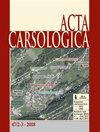厄瓜多尔加拉帕戈斯群岛火山管成因的新见解
IF 1.1
4区 地球科学
Q4 GEOSCIENCES, MULTIDISCIPLINARY
引用次数: 1
摘要
关于加拉帕戈斯火山的产物(或熔岩管)的起源和发展的研究很少。产物负责熔岩的侧向,喷发后的运输,因为它们是非常有效的隔热材料。火山喷发结束后,这些管道通常会变成洞穴。2014年3月,第16届火山洞穴学国际研讨会将一大群火山洞穴学专家带到群岛。在会议期间,参观了许多产品,并在圣克鲁斯岛和伊莎贝拉塞拉内格拉火山周围的背景下进行了研究,塞拉内格拉火山位于加拉帕戈斯最活跃的西部。最长的洞穴Cueva del Cascajo长约3公里,对其进行了部分调查,并参观了其他9个洞穴。结构特征,如屋顶的厚度、向下切割的证据、牛弓的存在、次级天花板、熔岩落、崩塌和普卡,被特别研究,以作为它们揭示产品发育阶段的证据。结果表明,产品是由“膨胀”形成的,主顶板由不间断的paŻhoehoe板组成。未发现由渠道覆壳形成的产物。这些研究有力地证实了从其他热点相关岛屿(如夏威夷)得出的推论。本文章由计算机程序翻译,如有差异,请以英文原文为准。
New insights into the genesis of pyroducts of The Galápagos islands, Ecuador
There has been little research on the genesis and development of pyroducts (or lava tubes) originating from Gala´pagos volcanoes. Pyroducts are responsible for the lateral, post-eruptive transport of lava because they are highly effective as thermal insulators. After eruptions terminate, these conduits often become accessible as caves. In March 2014 the 16th International Symposium on Vulcanospeleology brought a large group of vulcanospeleological specialists to the Islands. During the meeting a number of pyroducts were visited and studied in context on the island of Santa Cruz and around Isabella’s Sierra Negra volcano in the western, most active, part of the Gala´pagos. The longest of the caves, Cueva del Cascajo, about 3 km in length, was partly surveyed and nine other caves were visited. Structural features such as thickness of roof, evidence of downcutting, presence of oxbows, secondary ceilings, lavafalls, collapses and pukas were particularly studied for evidence they reveal about developmental stages of pyroducts. The resulting data show that the pyroducts were formed by "inflation" with the primary roof consisting of uninterrupted paŻhoehoe sheets. No pyroducts were identified that developed by the crusting-over of channels. The studies strongly confirm inferences drawn from other hot-spot related islands, such as Hawai’i.
求助全文
通过发布文献求助,成功后即可免费获取论文全文。
去求助
来源期刊

Acta Carsologica
地学-地球科学综合
CiteScore
1.50
自引率
14.30%
发文量
0
审稿时长
>12 weeks
期刊介绍:
Karst areas occupy 10-20 % of ice-free land. Dissolution of rock by natural waters has given rise to specific landscape and underground. Karst surface features and caves have attracted man''s curiosity since the dawn of humanity and have been a focus to scientific studies since more than half of millennia.
Acta Carsologica publishes original research papers and reviews, letters, essays and reports covering topics related to specific of karst areas. These comprise, but are not limited to karst geology, hydrology, and geomorphology, speleology, hydrogeology, biospeleology and history of karst science.
 求助内容:
求助内容: 应助结果提醒方式:
应助结果提醒方式:


